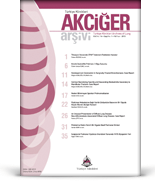Amaç: Akciğer hidatik kist cerrahisi sonrası morbidite %3-27 arasında değişirken, mortalite %0-2 arasındadır. Çalışmadaki amacımız, akciğer hidatik kist cerrahisi sonrası postoperatif komplikasyonlara neden olabilecek risk faktörlerini saptamaktır. Gereç ve Yöntemler: 2010 Ocak-2020 Aralık tarihleri arasında akciğer hidatik kisti nedeniyle opere edilen 137 hasta çalışmaya dâhil edildi. Hastaların yaş, cinsiyet, semptom, kan biyokimyasal değerleri, hidatik kistin büyüklüğü, yeri, rüptüre veya komplike olup olmadığı, cerrahi işlem, postoperatif komplikasyonlar, göğüs tüpü kalış süresi ve hastane yatış süresi hasta dosyaları incelenerek not edildi. Postoperatif komplikasyon gelişen hastalar Grup 1 olarak kabul edilirken, komplikasyon gelişmeyen hastalar Grup 2 olarak sınıflandırıldı. Postoperatif komplikasyonlar ile hastaların klinik ve radyolojik bulguları arasında anlamlı bir ilişki olup olmadığına bakıldı. Bulgular: Çalışmaya dâhil edilen 137 pulmoner hidatik kist hastasının 72'si (%52) erkek, 65'i (%47) ise kadın idi. Hastaların 9'unda (%6,5) atelektazi, 6'sında (%4,3) 3 günden fazla süren hava kaçağı, 2'sinde (%1,4) pnömoni ve 2'sinde (%1,4) yara yeri enfeksiyonu olmak üzere toplam 19 (%13,8) hastada postoperatif komplikasyon saptandı. Postoperatif mortalite saptanmadı. İstatistiksel incelemede; postoperatif komplikasyon gelişimi ile kistin büyüklüğü, kistin komplike olması, kistin rüptüre olması ve cerrahi sırasında rezeksiyon uygulanması arasında istatistiksel olarak anlamlı fark saptandı. Sonuç: Artan kist boyutu, kistin perforasyonu veya komplike olmasının, cerrahi zorluklara ve postoperatif komplikasyon insidansında artışa yol açabileceği sonucuna varılmıştır. Büyük hidatik kistlerde tanı konulur konulmaz cerrahi tedavi, perfore ve komplike hidatik kistlerde preoperatif yeterli tedavi, postoperatif komplikasyonları azaltabilir. Parankim koruyucu cerrahi her zaman önceliğimiz olmalıdır.
Anahtar Kelimeler: Ekinokokkoz; göğüs cerrahisi; komplikasyonlar
Objective: Morbidity after lung hydatid cyst surgery ranges from 3% to 27%, while mortality is between 0% and 2%. Our aim in study is to determine the risk factors that may cause postoperative complications after lung hydatid cyst surgery. Material and Methods: 137 patients who were operated for lung hydatid cyst between January 2010 and December 2020 were included in the study. Age, gender, symptoms, blood biochemical values, size and location of the hydatid cyst, whether it was ruptured or complicated, surgical procedure, postoperative complications, chest tube length of stay, and hospital stay were noted by examining the patient files. Patients with postoperative complications were considered as Group 1, while patients without complications were classified as Group 2. It was investigated whether there was a significant relationship between postoperative complications and the clinical and radiological findings of the patients. Results: Of the 137 pulmonary hydatid cyst patients included in the study, 72 (52%) were male and 65 (47%) were female. Atelectasis in 9 (6.5%) patients, air leak lasting more than 3 days in 6 (4.3%), pneumonia in 2 (1.4%) and wound site in 2 (1.4%) patients. Postoperative complications were detected in a total of 19 (13.8%) patients. No postoperative mortality was detected. In the statistical analysis, a statistically significant difference was found between the development of postoperative complications and the size of the cyst, the complexity of the cyst, the rupture of the cyst and the application of resection during surgery. Conclusion: It was concluded that increased cyst size, perforation or complication of the cyst may lead to surgical difficulties and an increased incidence of postoperative complications. Surgical treatment as soon as the diagnosis is made in large hydatid cysts, and adequate preoperative treatment in perforated and complicated hydatid cysts can reduce postoperative complications. Parenchyma sparing surgery should always be our priority.
Keywords: Echinococcosis; thoracic surgery; complications
- Topçu S, Kurul IC, Taştepe I, Bozkurt D, Gülhan E, Cetin G. Surgical treatment of pulmonary hydatid cysts in children. J Thorac Cardiovasc Surg. 2000;120(6):1097-101. [Crossref] [PubMed]
- Kanat F, Turk E, Aribas OK. Comparison of pulmonary hydatid cysts in children and adults. ANZ J Surg. 2004;74(10):885-9. [Crossref] [PubMed]
- Burgos R, Varela A, Castedo E, Roda J, Montero CG, Serrano S, et al. Pulmonary hydatidosis: surgical treatment and follow-up of 240 cases. Eur J Cardiothorac Surg. 1999;16(6):628-34; discussion 634-5. [Crossref] [PubMed]
- Cobanoglu U, Asker S. Complications of hydatid cysts in the lung. J Surg Surgical Res. 2015;1(2):23-8. [Link]
- Kuzucu A, Ulutas H, Reha Celik M, Yekeler E. Hydatid cysts of the lung: lesion size in relation to clinical presentation and therapeutic approach. Surg Today. 2014;44(1):131-6. [Crossref] [PubMed]
- Usluer O, Ceylan KC, Kaya S, Sevinc S, Gursoy S. Surgical management of pulmonary hydatid cysts: is size an important prognostic indicator? Tex Heart Inst J. 2010;37(4):429-34. [PubMed] [PMC]
- Ahmad M, Khan SA, Shah SZ, Nazar HS, Bilal A, Khan MA, et al. Effect of size on the surgical management of pulmonary hydatid cyst. J Ayub Med Coll Abbottabad. 2014;26(1):42-5. [PubMed]
- Ahmadinejad M, Hashemi M, Azizallahi N. Evaluation of prognostic factors associated with postoperative complications following pulmonary hydatid cyst surgery. Open Respir Med J. 2020;14:16-21. [Crossref] [PubMed] [PMC]
- Onal O, Demir OF. The relation between the location and the perforation rate of lung hydatid cysts in children. Asian J Surg. 2018;41(5):422-6. [Crossref] [PubMed]
- Santosh T, Patro MK, Bal AK, Behera B. Hydatid cyst at unusual locations: report of two cases. Human Pathology: Case Reports. 2017;8:59-61. [Crossref]
- Nabi MS, Waseem T. Pulmonary hydatid disease: what is the optimal surgical strategy? Int J Surg. 2010;8(8):612-6. [Crossref] [PubMed]
- Turna A, Yilmaz MA, Haciibrahimoğlu G, Kutlu CA, Bedirhan MA. Surgical treatment of pulmonary hydatid cysts: is capitonnage necessary? Ann Thorac Surg. 2002;74(1):191-5. [Crossref] [PubMed]







.: Process List